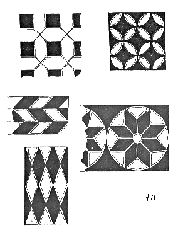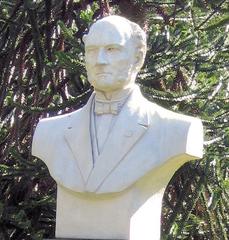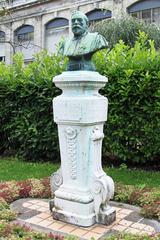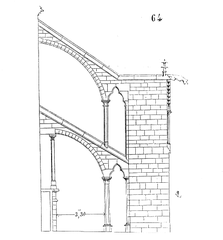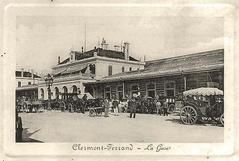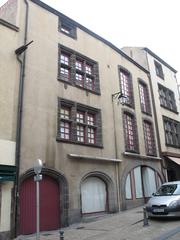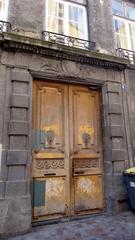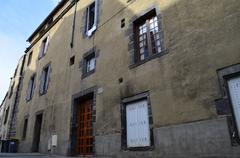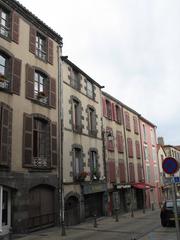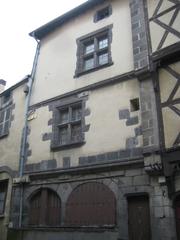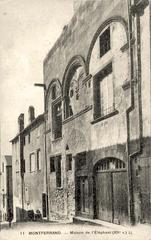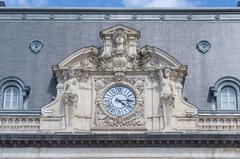Hôtel De Fontenilhes: Visiting Hours, Tickets, and Guide to Clermont-Ferrand Historical Sites
Date: 14/06/2025
Introduction
Located in the heart of Montferrand—the medieval district of Clermont-Ferrand, France—the Hôtel de Fontenilhes stands as a distinguished emblem of Renaissance architecture and French heritage. This grand hôtel particulier, constructed in the late 16th century, reflects not only the artistic ambitions of its era but also the economic and social ascent of Montferrand’s urban elite. Built from the region’s iconic Volvic lava stone, the mansion is a testament to Clermont-Ferrand’s unique architectural identity and the historical evolution of the city (Clermont Auvergne Volcans).
While primarily a private residence, the Hôtel de Fontenilhes is a highlight of guided heritage tours and European Heritage Days, offering visitors the opportunity to appreciate its striking exterior, rich sculptural details, and the broader context of Montferrand’s preserved medieval street plan.
This comprehensive guide covers the history, architecture, visiting information, and cultural context of the Hôtel de Fontenilhes, as well as practical tips for exploring the surrounding historical sites of Clermont-Ferrand (Wikipatrimoine; The Good Life France).
Table of Contents
- Historical and Urban Context
- Architectural Typology and Features
- Decorative Elements and Craftsmanship
- Preservation and Cultural Value
- Visitor Information
- Nearby Attractions
- FAQs
- Visitor Tips
- References and Further Reading
Historical and Urban Context
Montferrand’s Medieval Fabric
Founded in the 12th century as a bastide, Montferrand is renowned for its exceptionally preserved orthogonal street grid—an unusual feature in central France. This rational layout fostered the development of prestigious urban mansions, or hôtels particuliers, like the Hôtel de Fontenilhes (Clermont Auvergne Volcans). The town’s urban design, still visible today, allowed the elite to establish grand residences while contributing to Montferrand’s defensive and orderly character.
Social and Economic Significance
The Hôtel de Fontenilhes was built during a period of prosperity when Montferrand’s bourgeoisie and nobility sought to reflect their status through impressive architecture. The Fontenilhes family, prominent in local society, commissioned this mansion as both a home and a symbol of their influence (Auvergne Centre France).
Architectural Typology and Features
The Hôtel Particulier Model
The Hôtel de Fontenilhes exemplifies the Renaissance hôtel particulier, defined by its:
- Imposing volcanic stone façade with heraldic and sculptural motifs.
- Central courtyard, providing privacy and natural light.
- Clear separation of public reception areas and private quarters.
- Distinctive Volvic lava stone, contributing to the dark, striking appearance characteristic of Clermont-Ferrand.
The structure is organized around two main building wings, enclosing the central courtyard. The galleries on three levels, supported by robust pillars and exhibiting the classical orders—Doric, Ionic, and Corinthian—are a direct reference to Renaissance architectural theory (Auvergne Centre France).
Decorative Elements and Craftsmanship
Sculptural and Ornamental Highlights
The mansion’s most celebrated features include:
- Staircase turret: Adorned with intricately carved lions, griffons, and unicorns—Renaissance symbols of strength, vigilance, and purity.
- Stone window frames and doorways: Featuring ogee arches or straight lintels, often embellished with foliage or grotesques.
- Wrought iron balconies and window grilles: Demonstrating local artisans’ skill.
The careful execution of these motifs and the rare survival of such decorative art make the Hôtel de Fontenilhes a key example of regional Renaissance craftsmanship (Wikipatrimoine).
Volvic Lava Stone
The use of durable and locally sourced Volvic lava stone not only ensured the building’s resilience but also imbued it with a distinctive, solemn appearance. This material is central to Clermont-Ferrand’s architectural identity, linking the Hôtel de Fontenilhes to the city’s broader built heritage (The Good Life France).
Preservation and Cultural Value
Heritage Status and Conservation
The Hôtel de Fontenilhes is protected as a historical monument, reflecting its architectural and cultural significance. Conservation efforts focus on maintaining the building’s structural integrity and sculptural details, addressing the unique challenges posed by the volcanic stone.
Urban and Artistic Importance
The mansion is a window into Montferrand’s past, illustrating the rise of a new urban elite and the diffusion of Renaissance ideas in provincial France. Its survival, along with other hôtels particuliers in the district, offers rare insight into domestic life and artistic tastes of the 16th and 17th centuries (Auvergne Centre France).
Visitor Information
Visiting Hours and Ticketing
- Exterior Viewing: The façade and courtyard are visible from the street year-round, free of charge.
- Special Access: Interior access is only possible during events such as the European Heritage Days (Journées Européennes du Patrimoine) in September, or during guided tours organized by the Clermont Auvergne Volcans Tourist Office.
- Tickets: No regular ticketing; fees may apply for special tours or events. Check the tourist office website for updates.
Accessibility
- The exterior and courtyard are generally accessible with paved paths, but interior access is limited and may not be fully wheelchair accessible.
- Historic cobblestone streets and uneven surfaces may pose challenges for visitors with reduced mobility.
Getting There
- Public Transport: Reachable by T2C bus (Montferrand Fontaine stop), Tram A, and C-Vélo bike stations.
- Parking: Limited within the historic core; public transport is recommended.
Nearby Attractions
While in Montferrand, consider visiting:
- Hôtel de Fontfreyde: Another Renaissance mansion.
- Église Notre-Dame-de-Prospérité: A historic church within walking distance.
- Maison de l’Elephant: A unique 13th-century Romanesque house.
- Timber-Framed Houses: Exemplifying medieval and Renaissance construction.
- Local eateries and cheese shops: Such as Le Bistrot de la Butte and Fromagerie Nivesse (The Good Life France).
Explore our articles on medieval architecture in Auvergne and Clermont-Ferrand’s historical sites for further insights.
FAQs
Q: What are the visiting hours for Hôtel de Fontenilhes?
A: The exterior and courtyard are viewable from the street at any time. Interior access is limited to special events.
Q: Are tickets required?
A: No regular fee for exterior viewing; tickets may be needed for guided tours or special events.
Q: Are guided tours available?
A: Yes, especially during heritage events. Book through the Clermont Auvergne Volcans Tourist Office.
Q: Is the site accessible for people with disabilities?
A: The exterior is generally accessible, but the interior may have limitations. Check with the tourist office for details.
Q: What other attractions are nearby?
A: Montferrand offers numerous historical sites, eateries, and museums within walking distance.
Visitor Tips
- Plan Ahead: Confirm tour dates and special event schedules.
- Photography: Best lighting is in the early morning or late afternoon.
- Respect Privacy: The mansion is a private residence; do not enter unless with an official tour.
- Combine Visits: Pair your trip with other Montferrand landmarks for a full experience.
- Use Digital Resources: Download the Audiala app for guided tours and updates.
References and Further Reading
- Cité Médiévale de Montferrand, 2024, Clermont Auvergne Volcans (Clermont Auvergne Volcans)
- Hôtels Particuliers à Clermont-Ferrand, 2024, Auvergne Centre France (Auvergne Centre France)
- Hôtel de Fontenilhes à Montferrand, 2024, Wikipatrimoine (Wikipatrimoine)
- Guide to Clermont-Ferrand, 2024, The Good Life France (The Good Life France)
For the latest news, guided tour dates, and insider tips, download the Audiala app and follow our channels. Discover why the Hôtel de Fontenilhes remains one of Auvergne’s most captivating historical treasures.
